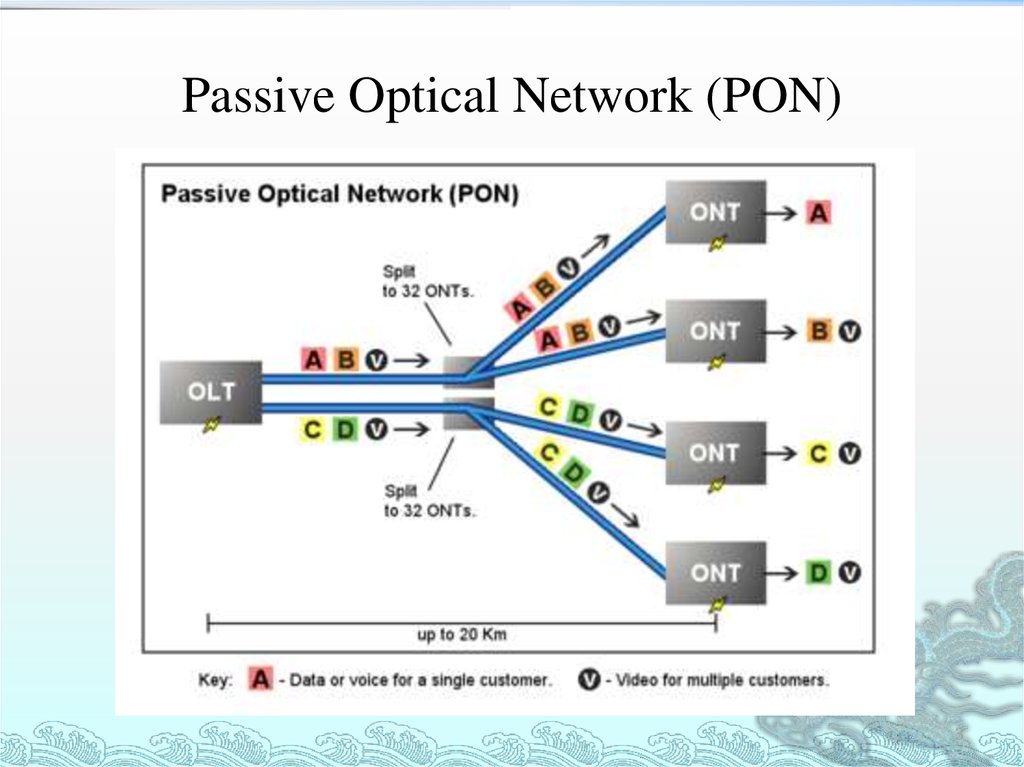With technologies advancing at an exponential rate, organizations are looking for network infrastructures that can support high bandwidth applications and facilitate seamless connectivity. Passive Optical LAN (POL) is emerging as a viable solution that delivers fiber directly to end devices, enabling lightning fast connectivity without compromising on reliability or scalability.
What is POL?
A Passive Optical LAN or POL is a fiber to the desk network architecture that utilizes point-to-multipoint fiber connectivity to deliver high bandwidth directly to individual desktops and devices. In a POL network, a single optical fiber is used to transmit information, both downstream from the central office to several endpoints using a passive optical splitter, and upstream from the endpoints using an optical multiplexer or Wavelength Division Multiplexing (WDM).
Unlike traditional switched Ethernet networks that have active components like switches and hubs at various points, a POL network relies completely on passive optical splitters and combiners for signal distribution. This passive infrastructure makes the network much more reliable by eliminating any potential points of failure due to powered components. The use of optical fiber as the transmission medium also makes it future proof with virtually unlimited bandwidth to support growing connectivity demands.
Benefits of POL
The key benefits that POL provides over traditional network architectures include:
Higher Bandwidth: With fiber optic cables serving as the backbone, POL networks can deliver bandwidth of 1 Gbps or higher to every connected device. This massive bandwidth makes it well-suited for 4k video, IoT, telemedicine and other data-intensive applications.
Scalability: Thanks to its point-to-multipoint architecture, new endpoints can be added to a POL network by simply plugging them into the existing optical infrastructure. The passive splitters facilitate easy scale-out without any need to introduce new active components.
Reliability: As POL networks rely completely on passive components for signal distribution, there are no single points of failure that could bring the entire network down. Even if one distribution fiber is cut, it will only affect a small localized portion of users.
Low Upfront and Operational Costs: POL requires less fiber cabling and hardware compared to traditional LAN alternatives. Once installed, it has negligible operational costs since there is no need for power-hungry active components.
Improved Security: With data transmitted through optical fibers that are difficult to tap into unauthorizedly, POL networks provide better physical layer security compared to analogue copper cables.
How POL Works
A typical POL network consists of these key components:
– Optical Line Terminal (OLT): Located at the central office, the OLT acts as the source for downstream optical signals. It houses the laser transmitters and associated multiplexing equipment.
– Optical Distribution Network (ODN): Consists of optical splitters/combiners located in local interconnect cabinets which split/combine the upstream and downstream optical signals.
– Optical Network Terminal (ONT): Housed at the user premises, the ONT contains a laser receiver for downstream and a transmitter for upstream. It converts the optical signals to electrical for user devices.
The OLT transmits data downstream to the ODN using a dedicated wavelength. The passive splitters then broadcast this signal to all ONTs connected. For upstream, the ONTs transmit data on a separate wavelength which the combiners multiplex back to the OLT on a single fiber.
Use Cases For POL Deployment
While POL delivers the same benefits for all organizations, some specific use cases that stand to gain most include:
– Educational Institutions: Colleges and schools can leverage POL’s massive bandwidth to foster a digital learning environment through 1:1 computing initiatives and interactive educational applications.
– Healthcare Facilities: Passive Optical LAN is well-suited for telemedicine networks, real-time medical imaging and analytics. With dependability and security, it supports mission-critical healthcare workflows.
– Enterprises: Large offices and campuses implementing IoT, virtual/augmented reality and data-intensive workflows get a future-ready infrastructure with POL that stays ahead of technological changes.
– Smart Buildings: POL facilitates sensor networking and data collection backbone needed for integrated smart lighting, HVAC, security and other building automation systems.
– Mobile Networks: When deployed at cellular towers, POL strengthens backhaul connectivity for 5G rollouts and other bandwidth-hungry wireless services.
The Road Ahead
Global telecom operators and tech giants are continuously working on enhancements to existing POL standards that can further improve its capabilities. Some advancements expected in the near future include:
– 10G PON: Next generation XGS-PON and NG-PON2 standards promise symmetrical 10Gbps bandwidth per user over a single strand of fiber.
– Dynamic Bandwidth Allocation: More intelligent bandwidth allocation algorithms will optimize resource utilization based on real-time traffic patterns.
– Long Reach PON: Extended reach of over 100km enabled by technologies like LS-PON that have applications in rural broadband connectivity.
– Mobile Fronthaul: Integrating POL/FTTx with 5G wireless will facilitate delivery of bandwidth-intensive low-latency fronthaul services.
As network demands grow exponentially, POL is clearly the fiber infrastructure of the future that holds the potential to future-proof organizations by delivering bandwidth capabilities far more than what’s needed today. With continuous innovation, POL networks will only get faster, more reliable and future-ready.
Note:
1. Source: Coherent Market Insights, Public sources, Desk research
2. We have leveraged AI tools to mine information and compile it




